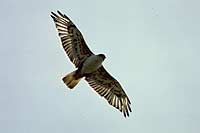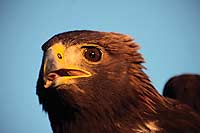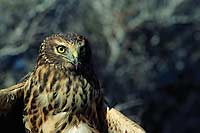Winter wildlife watching, especially for birds of prey such as hawks, eagles, falcons, and owls, can be very rewarding in Canyon Country. It’s talon time out there, and are emerging prey.
 Rough-legged hawks, which bred in northern Alaska and in arctic regions across Canada and parts of Eurasia, are winter residents of open country in the lower 48 and southern Canada. These hawks, close relative of red-tailed hawks, prey on small mammals. Agricultural fields and open grasslands such as the Cisco and Green River Deserts are excellent areas to check for these buteos. The birds perch on utility poles and fence posts or directly on the ground and may also be observed hovering in the air like an American kestrel while hunting. Light-colored heads, dark belly bands, whitish tails with dark bands, and dark carpal patches (dark squares near the wrist) on the undersides of the wings are all good field marks to help identify these hawks with legs feathered to their toes; hence, their common name.
Rough-legged hawks, which bred in northern Alaska and in arctic regions across Canada and parts of Eurasia, are winter residents of open country in the lower 48 and southern Canada. These hawks, close relative of red-tailed hawks, prey on small mammals. Agricultural fields and open grasslands such as the Cisco and Green River Deserts are excellent areas to check for these buteos. The birds perch on utility poles and fence posts or directly on the ground and may also be observed hovering in the air like an American kestrel while hunting. Light-colored heads, dark belly bands, whitish tails with dark bands, and dark carpal patches (dark squares near the wrist) on the undersides of the wings are all good field marks to help identify these hawks with legs feathered to their toes; hence, their common name.
 Other members of the Buteo genus (buteo means “soaring hawk”) that hang around in winter are ferruginous hawks and red-tailed hawks. Sight any medium-sized, chunky looking hawk in winter and a good guess would be redtail without even seeing the brick-red tail. These hawks occur in open forests, canyons, open country, and agricultural fields. Redtails in winter may either be year-round residents or winter residents that will move north in the spring. Resident birds may start pair bonding in late winter, they mate for life, so look for two red-tailed hawks turning lazy circles together, at times emitting one of their raspy “screams.”
Other members of the Buteo genus (buteo means “soaring hawk”) that hang around in winter are ferruginous hawks and red-tailed hawks. Sight any medium-sized, chunky looking hawk in winter and a good guess would be redtail without even seeing the brick-red tail. These hawks occur in open forests, canyons, open country, and agricultural fields. Redtails in winter may either be year-round residents or winter residents that will move north in the spring. Resident birds may start pair bonding in late winter, they mate for life, so look for two red-tailed hawks turning lazy circles together, at times emitting one of their raspy “screams.”
Another hawk observed coursing over open country or marshlands is the northern harrier, formerly known as the marsh hawk. This sleek, slimmer hawk has a long, narrow tail with a distinctive white rump patch above and broad wings that are held in a slight V pattern. As a harrier courses low over fields or flats, they look and listen for prey. A harrier facial disk, similar to that of an owl, helps channel sound into their ear canals. Able to triangulate the sound of prey moving even in deep grass or reeds, the harrier may hover briefly before plunging in after prey with their long legs.
In addition to the hawks and swift-flying falcons such as the peregrine, prairie, merlin, and American kestrel, large golden and bald eagles may also be viewed in winter. Both eagles may be observed in open country hunting small mammals or feeding on roadkill. Bald eagles also prey on waterfowl and fish, so they may be seen perched in cottonwoods or flying above the river. Golden eagles prey mostly on mammals, so think open country with nearby cliffs where the birds may perch or nest later in the season.
Sharing cliff faces or even cottonwood trees for nest sites are great horned owls. These large predators represent the nocturnal version of the daytime-hunting hawks and eagles. Roosting during the day, these owls hunt for rodents, small mammals, skunks, feral cats, and other creatures, earning them the nickname “Flying Tigers.” Their classic hooting calls echo against canyon walls or across woodlands, calling to mates, protecting territories, and possibly making their prey a little jumpier.
Late winter is an ideal time to view this watchable wildlife because they occur in diverse habitats, are easy to spot due to their size, and are not hidden by spring’s green foliage. For more information on birding Moab, visit discovermoab.com/bird-watching and good birding to you!